Shrubs of the Adirondacks:
Sheep Laurel (Kalmia angustifolia)
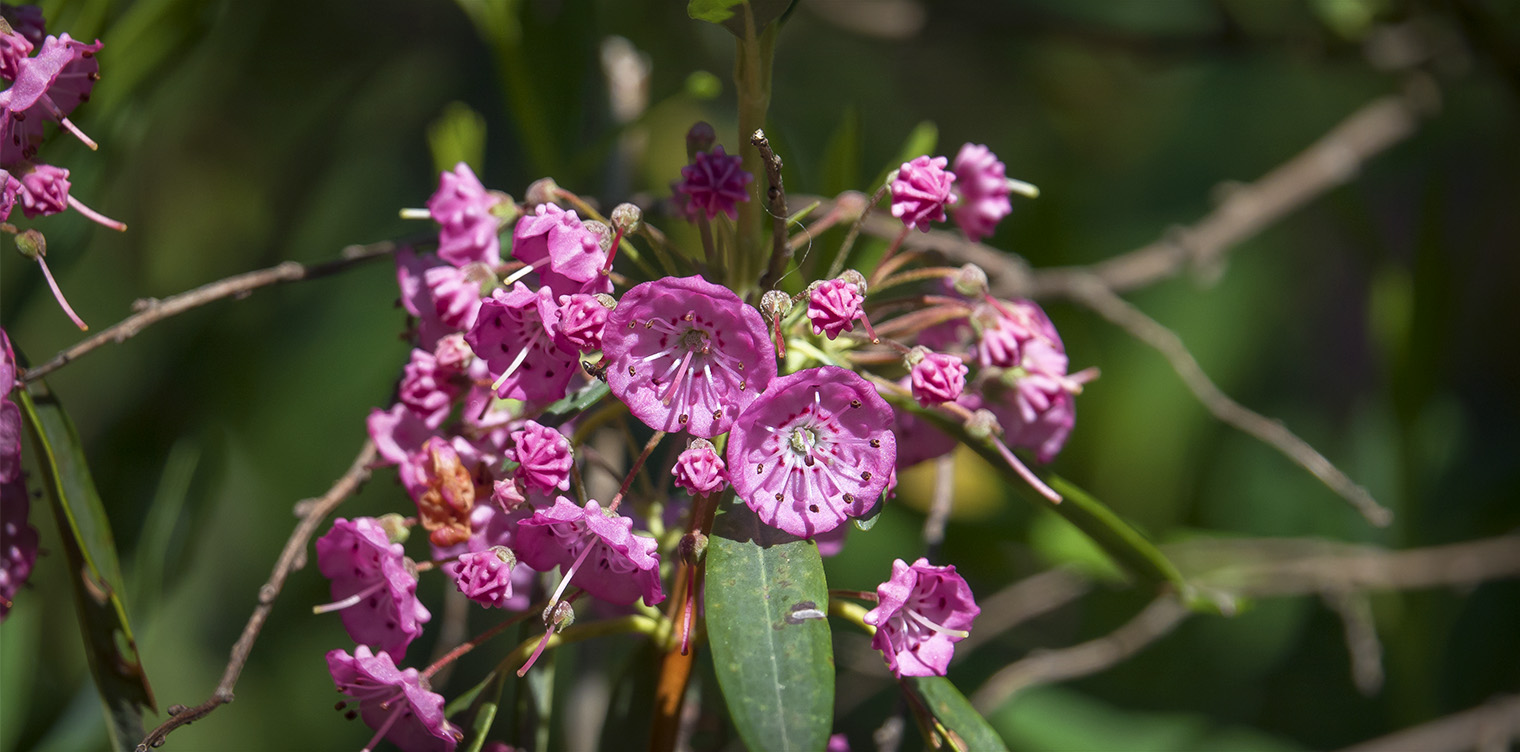
Sheep Laurel (Kalmia angustifolia) is a low evergreen shrub which grows in bogs, swamps, other wetlands, and alpine summits in the Adirondack region of upstate New York. This plant bears a cluster of deep pink flowers in late spring and early summer.
Sheep Laurel is a member of the Heath family. The genus name (Kalmia) is in honor of Peter Kalm, a student of Linnaeus. Kalm was a Swedish-Finish botanist and naturalist who traveled and collected plants in the Americas during the 18th century. The term augustifolia means narrow-leaved. Other common names include Dwarf-laurel, Lambkill, Sheepkill, and Calfkill. The latter names reflect the fact that the foliage of Sheep Laurel is poisonous to livestock.
Identification of Sheep Laurel
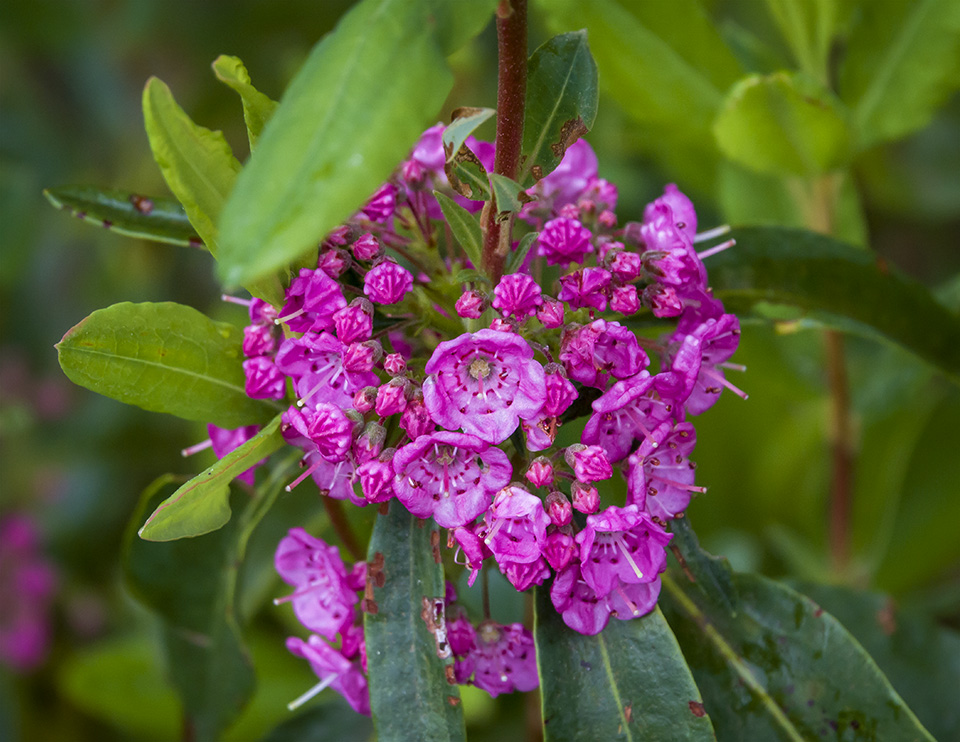
Sheep Laurel is a small evergreen shrub that grows about three feet tall. The stems tend to trail on the ground, with erect branch tips at the end. The bark is brown to gray.
The leaves of the Sheep Laurel are glossy, narrowly oval, and somewhat leathery. They are blue-green, turning reddish-green to purple in fall. The leaves, which are 1.5 to 2.5 inches long, are opposite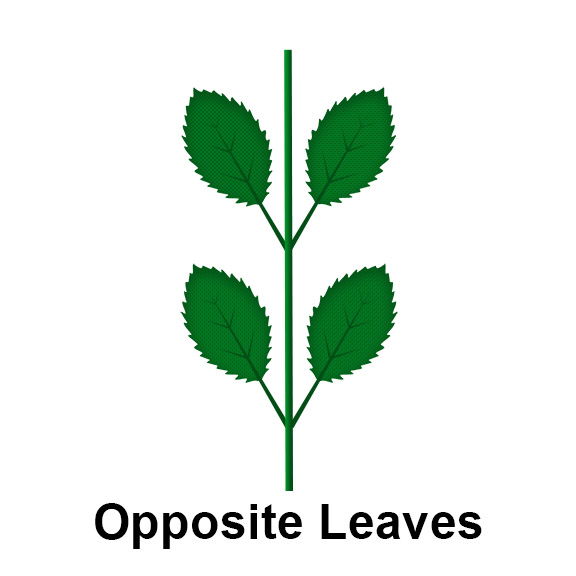 Opposite Leaves: Leaves occurring in pairs at a node, with one leaf on either side of the stem. (meaning that two appear at a node) or in whorls of three. The edges are smooth
Opposite Leaves: Leaves occurring in pairs at a node, with one leaf on either side of the stem. (meaning that two appear at a node) or in whorls of three. The edges are smooth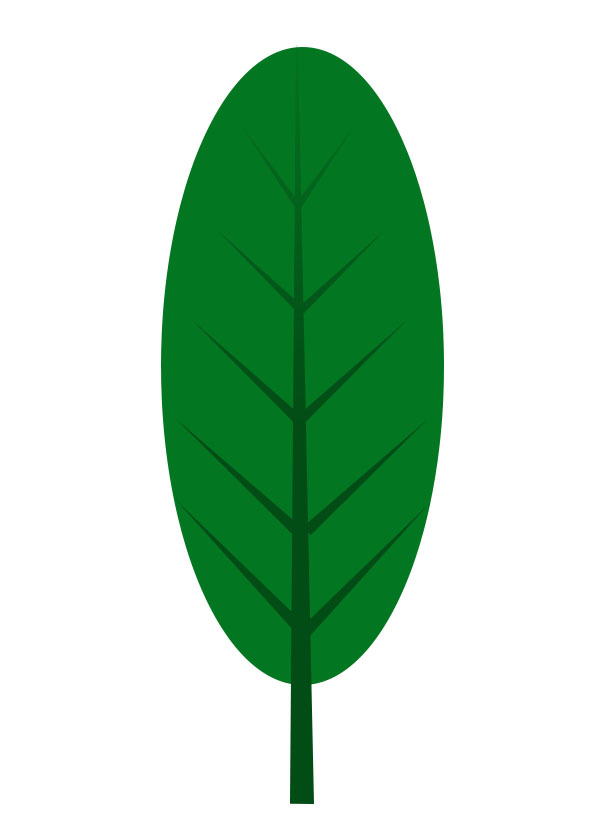 Smooth leaf edges do not have any teeth., without teeth.
Smooth leaf edges do not have any teeth., without teeth.
Sheep Laurel flowers are arranged in clusters of deep pink flowers. Each of the small, saucer-shaped flowers has five dark pink petals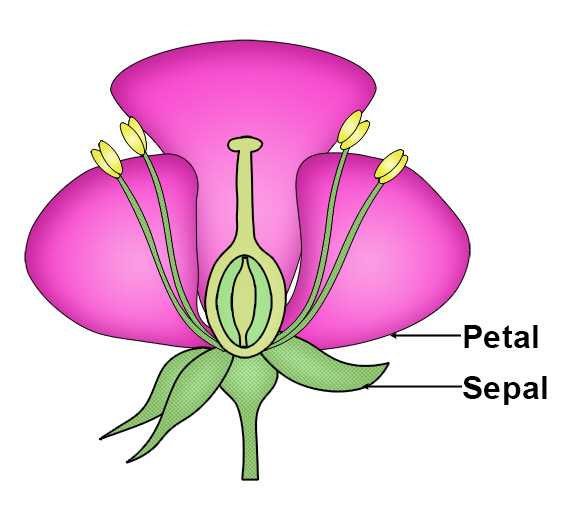 Petals: Modified leaves that surround the reproductive parts of flowers. Petals are often brightly colored or unusually shaped to attract pollinators. and ten stamens
Petals: Modified leaves that surround the reproductive parts of flowers. Petals are often brightly colored or unusually shaped to attract pollinators. and ten stamens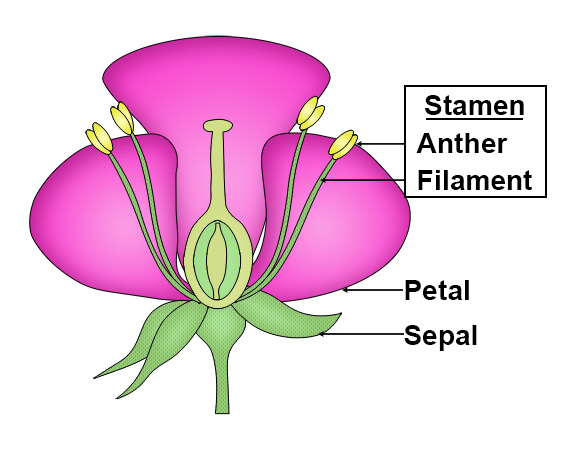 Stamen: The male part of the flower, made up of the filament and anther.. The flowers appear underneath the new leaves, and the flower cluster encircles the stem.
Stamen: The male part of the flower, made up of the filament and anther.. The flowers appear underneath the new leaves, and the flower cluster encircles the stem.
Sheep Laurel generally flowers in very late spring to early summer. A tally of flowering dates for the upland Adirondack areas compiled by Michael Kudish, based on data collected from the early seventies to the early nineties, lists the earliest flowering time as 12 June in upland areas and the median date as 20 June. This is consistent with flowering times in more recent years. The pattern of bloom dates indicated by iNaturalist Sheep Laurel observations within the Adirondack Park suggest a flowering period from late June through mid- to late July in most years. According to a plant atlas published the late 19th century, Sheep Laurel plants growing on mountain summits bloomed much later, in August.
The flowers are followed by fruit, which is present from August through autumn. The fruit is a small capsule, containing many seeds. The fruit appears below the top cluster of leaves. Capsules reportedly can remain on the branches for several years.
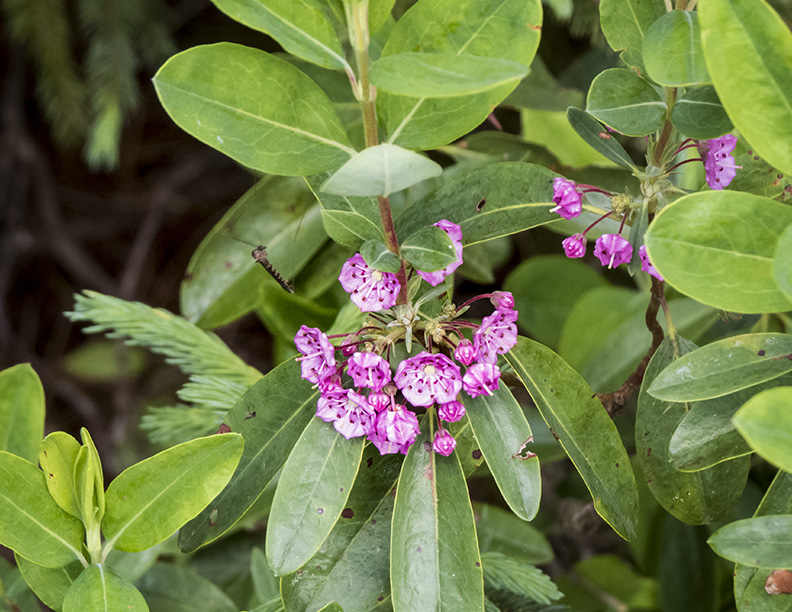
Keys to differentiating Sheep Laurel from other shrubs growing in swampy or boggy habitats include leaf arrangement, shape, and color, as well as the color and arrangement of the flowers.
- Sheep Laurel can be distinguished from Bog Laurel by the placement of its flowers. While the flowers are quite similar, those of the Bog Laurel form clusters at the end of the stem. The flowers of the Sheep Laurel, by contrast, appear a few inches from the top of the stem, with newer leaves above the cluster of flowers. In addition, Sheep Laurel leaves lack the in-rolled edges and white undersides of Bog Laurel leaves. Moreover, Sheep Laurel twigs do not feature two edges, as Bog Laurel leaves do.
- Both Sheep Laurel and Bog Rosemary have pink flowers, but the shape and placement is very different. Sheep Laurel flowers appear in clusters grouped near the previous year's leaves; that is, the leaves appear farther down on the branch, with new leaf growth above. Bog Rosemary flowers are lighter pink, bell-shaped, and appear in clusters at the end of the branch.
- Sheep Laurel can also be distinguished from Leatherleaf by the color and placement of its flowers. Sheep Laurel's crimson-pink flowers are quite different from Leatherleaf's white bells. In addition, Leatherleaf's alternate
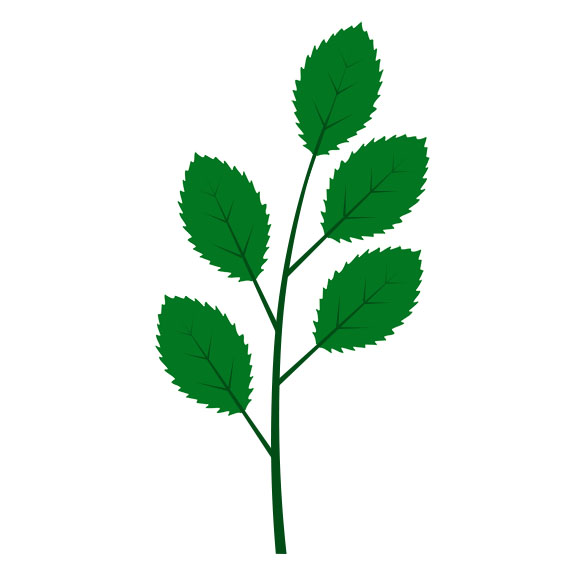 Alternate: An arrangement of leaves (or buds) on a stem (or twig) in which the leaves emerge from the stem one at a time. This often makes the leaves appear to alternate on the stem. leaves contrast with Sheep Laurel's opposite or whorled leaves.
Alternate: An arrangement of leaves (or buds) on a stem (or twig) in which the leaves emerge from the stem one at a time. This often makes the leaves appear to alternate on the stem. leaves contrast with Sheep Laurel's opposite or whorled leaves. - Sheep Laurel can be distinguished from Labrador Tea by both the flowers and the leaves. Labrador Tea's cluster of white flowers appears on the end of the stem, while the deep pink flowers of Sheep Laurel appear a few inches from the top of the stem, with newer leaves above the cluster of flowers. In addition, Sheep Laurel leaves lack the in-rolled edges of Labrador Tea leaves.
Uses of Sheep Laurel
Sheep Laurel is a very poisonous plant and has no edible uses. This plant is used little, if at all, in modern herbalism. Most Native American groups considered the plant very dangerous. However, some used it to treat a variety of ailments. They sometimes used the leaves of the plant externally as a poultice for skin diseases, sprains, and swelling.
Wildlife Value of Sheep Laurel
Sheep Laurel is not used as a browse by mammals. However, it is one of the larval food plants for the Brown Elfin butterfly.
Distribution of Sheep Laurel
Sheep Laurel is found in northeastern North America from Newfoundland and Labrador west through Ontario and south through Michigan. It is found in most counties in the eastern part of New York State, where it is listed as exploitably vulnerable. This plant is common in the Adirondack Mountains and is found in all counties within the Adirondack Park Blue Line.
Habitat of Sheep Laurel
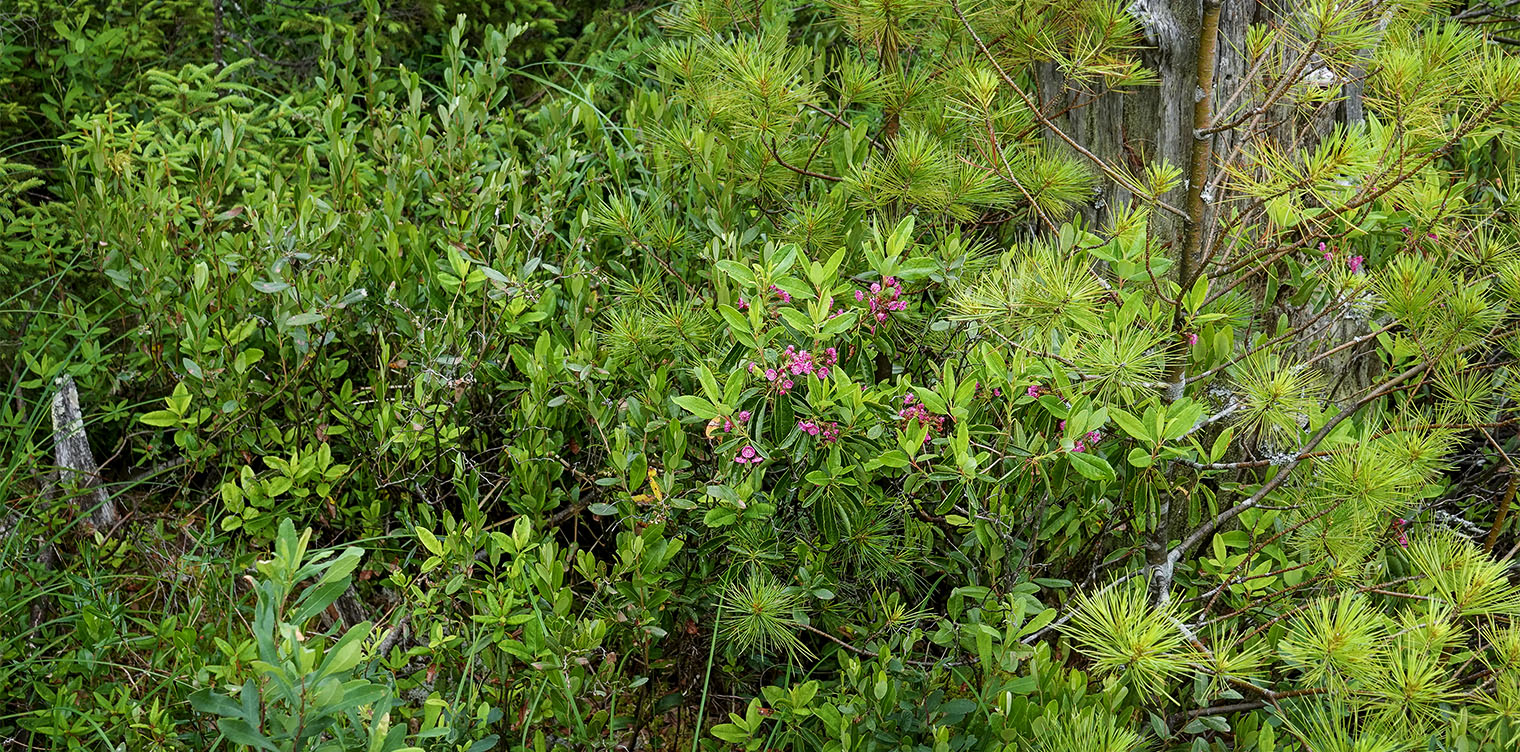
Sheep Laurel is classified as a Facultative plant (FAC), meaning that it occurs in both wetlands and nonwetlands. This species can grow on poorly drained to well-drained sites. It is shade-intolerant, but can also survive in semi-open sites and can be found on both open and wooded sites. It does best in acid soils, including the peats of bogs and acidic fens.
Sheep Laurel is a common under-story shrub in sub-alpine forests, wet acidic peatlands, and forest edges. Because it has less exacting site requirements, Sheep Laurel can be found in a much wider range of habitats than Bog Laurel. Bog Laurel is much more restricted in its environment, growing only in bog-like conditions.
In the Adirondack Park, Sheep Laurel is found in a number of varied ecological communities, including:
Look for Sheep Laurel along Adirondack trails which pass through boggy or swampy habitat. One convenient place to see this plant is in Barnum Bog at the Paul Smith's College VIC, where it can be seen from the boardwalk on the Boreal Life Trail. You can also see Sheep Laurel on the edges of Heron Marsh, on the John Brown Farm Trails, along the marshy shore of Heart Lake, along the Bloomingdale Bog Trail, and on the summits of the High Peaks, where it usually blooms much later than at lower elevations.
References
Michael Kudish. Adirondack Upland Flora: An Ecological Perspective (Saranac, New York: The Chauncy Press, 1992), pp. 143-144.
New York Flora Association. New York Flora Atlas. Kalmia angustifolia L. var. angustifolia. Retrieved 10 April 2017.
United States Department of Agriculture. The Plants Database. Sheep Laurel. Kalmia angustifolia L. Retrieved 10 April 2017.
United States Department of Agriculture. Fire Effects Information System (FEIS). Species Reviews. Kalmia angustifolia. Retrieved 10 April 2017.
Flora of North America. Kalmia angustifolia Linnaeus. Retrieved 10 April 2017.
Northern Forest Atlas. Images. Sheep Laurel. Retrieved 10 April 2017.
New York State. Department of Environmental Conservation. New York Natural Heritage Program. Ecological Communities of New York State. Second Edition (March 2014), pp. 63-64, 64, 76, 101-102, 102-103, 108-109, 121-122, 122, 60-61. Retrieved 17 October 2015.
New York Natural Heritage Program. 2021. Online Conservation Guide for Black Spruce-Tamarack Bog. Retrieved 26 June 2021.
New York Natural Heritage Program. 2021. Online Conservation Guide for Highbush Blueberry Bog Thicket. Retrieved 26 June 2021.
New York Natural Heritage Program. 2021. Online Conservation Guide for Dwarf Shrub Bog. Retrieved 26 June 2021.
New York Natural Heritage Program. 2021. Online Conservation Guide for Ice Cave Talus Community. Retrieved 26 June 2021.
New York Natural Heritage Program. 2021. Online Conservation Guide for Inland Poor Fen. Retrieved 26 June 2021.
New York Natural Heritage Program. 2021. Online Conservation Guide for Patterned Peatland. Retrieved 26 June 2021.
New York Natural Heritage Program. 2021. Online Conservation Guide for Pitch Pine-Heath Barrens. Retrieved 26 June 2021.
New York Natural Heritage Program. 2021. Online Conservation Guide for Pitch Pine-Oak-Heath Rocky Summit. Retrieved 26 June 2021.
New York Natural Heritage Program. 2021. Online Conservation Guide for Sandstone Pavement Barrens. Retrieved 26 June 2021.
New York Natural Heritage Program. 2021. Online Conservation Guide for Spruce Flats. Retrieved 26 June 2021.
New York Natural Heritage Program. 2021. Online Conservation Guide for Vernal Pool. Retrieved 26 June 2021.
New York State. Adirondack Park Agency. Preliminary List of Species Native Within the Adirondack Park Listed Alphabetically by Scientific Name and Sorted by Habit. Volume 1. Updated 10.23.2006, p. 10. Retrieved 26 January 2017.
Lady Bird Johnson Wildflower Center. Kalmia angustifolia L. Retrieved 10 April 2017.
iNaturalist. Sheep Laurel. Kalmia angustifolia. Retrieved 26 June 2021.
iNaturalist. Adirondack Park Observations. Sheep Laurel. Kalmia angustifolia. Retrieved 26 June 2021.
Plants for a Future. Kalmia angustifolia - L. Retrieved 10 April 2017.
University of Michigan. Native American Ethnobotany. A Database of Foods, Drugs, Dyes and Fibers of Native American Peoples, Derived from Plants. Kalmia angustifolia L. Retrieved 10 April 2017.
The Cornell Lab of Ornithology. Birds of North America. Subscription web site. Yellow-bellied Flycatcher. Retrieved 10 April 2017.
William K. Chapman and Alan E. Bessette. Trees and Shrubs of the Adirondacks: A Field Guide (North Country Books, 1990), p. 97, Plate 25.
John Eastman. The Book of Swamp and Bog: Trees, Shrubs, and Wildflowers of Eastern Freshwater Wetlands (Stackpole Books, 1995), pp. 102-103.
Ronald B. Davis. Bogs & Fens. A Guide to the Peatland Plants of the Northeastern United States and Adjacent Canada (University Press of New England, 2016), pp. 106-107.
Donald W. Stokes. The Natural History of Wild Shrubs and Vines. Eastern and Central North America (Harper & Row, Publishers, 1981), pp. 181-184.
Anne McGrath. Wildflowers of the Adirondacks (EarthWords, 2000), pp. 29, 47.
Doug Ladd. North Woods Wildflowers (Falcon Publishing, 2001), p. 75.
Lawrence Newcomb. Newcomb's Wildflower Guide (Little Brown and Company, 1977), pp. 292-293.
Roger Tory Peterson and Margaret McKenny. A Field Guide to Wildflowers. Northeastern and North-central North America (Houghton Mifflin Company, 1968) pp. 228-229.
William K. Chapman, et al. Wildflowers of New York in Color (Syracuse University Press, 1998), pp. 56-57.
National Audubon Society. Field Guide to Wildflowers. Eastern Region. (Alfred A. Knopf, 2001), pp. 509-510, 512.
Peter Kalm. Travels Into North America. Volume 1 (London, 1773). Retrieved 21 June 2012.
Allen J. Combes. Dictionary of Plant Names (Timber Press, 1994), p. 99.
Charles H. Peck. Plants of North Elba. (Bulletin of the New York State Museum, Volume 6, Number 28, June 1899), p. 113. Retrieved 22 February 2017.
Shrubs of the Adirondack Park
